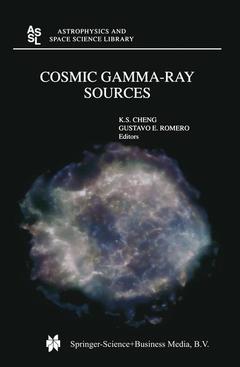Description
Cosmic Gamma-Ray Sources, 2004
Astrophysics and Space Science Library Series, Vol. 304
Coordinators: Cheng K.S., Romero Gustavo E.
Language: English
Subjects for Cosmic Gamma-Ray Sources:
Cosmic gamma-ray sources
Publication date: 03-2011
408 p. · 15.5x23.5 cm · Paperback
Publication date: 03-2011
408 p. · 15.5x23.5 cm · Paperback
Cosmic gamma-ray sources, (Astrophysics & space science library, Vol. 304)
Publication date: 10-2004
408 p. · 15.5x23.5 cm · Hardback
Publication date: 10-2004
408 p. · 15.5x23.5 cm · Hardback
Description
/li>Contents
/li>
Gamma-ray astronomy has undergone an enormous progress in the last 15 years. The success of satellite experiments like NASA's Comp ton Gamma-Ray Observatory and ESA's INTEGRAL mission, as well as of ground-based instruments have open new views into the high-energy Universe. Different classes of cosmic gamma-ray sources have been now detected at different energies, in addition to young radio pulsars and gamma-ray bursts, the classical ones. The new sources include radio quiet pulsars, microquasars, supernova remnants, starburst galaxies, ra dio galaxies, flat-spectrum radio quasars, and BL Lacertae objects. A large number of unidentified sources strongly suggests that this brief enumeration is far from complete. Gamma-ray bursts are now estab lished as extragalactic sources with tremendous energy output. There is accumulating evidence supporting the idea that massive stars and star forming regions can accelerate charged particles up to relativistic ener gies making them gamma-ray sources. Gamma-ray astronomy has also proved to be a powerful tool for cosmology imposing constraints to the background photon fields that can absorb the gamma-ray flux from dis tant sources. All this has profound implications for our current ideas about how particles are accelerated and transported in both the local and distant U niverse. The evolution of our knowledge on the gamma-ray sky has been so fast that is not easy for the non-specialist scientist and the graduate student to be aware of the full potential of this field or to grasp the fundamentals of a given topic in order to attempt some original contribution.
1 Introduction.- 1 The early years of gamma-ray astronomy.- 2 The age of the spark chambers.- 3 The Compton gamma-ray observatory.- 4 Gamma-ray line astronomy.- 5 The development of ground-based high-energy gamma-ray astronomy.- 6 Cosmic gamma-ray sources.- 7 Suggested reading.- 2 Fundamentals of gamma-ray astrophysics.- 1 Basic concepts.- 2 Gamma-ray production: thermal mechanisms.- 3 Non-thermal gamma-ray production: particle—field interactions.- 4 Non-thermal gamma-ray production: particle-matter interactions.- 5 Gamma-ray line production.- 6 Gamma-ray absorption processes.- 7 Doppler and gravitational shifts of gamma rays.- 8 Related physical processes.- 3 Galactic gamma-ray sources.- 1 Young sources in star-forming regions.- 2 Variable sources in the inner spiral arms.- 3 Variable sources in the halo.- 4 Extragalactic gamma-ray sources.- 1 Low-, mid-, and high-latitude sources.- 2 The case for AGNs.- 3 EGRET observations of AGNs.- 4 Microlensing of -?-ray blazars.- 5 Alternative origins of high-latitude ?-ray sources.- 6 EGRET detections and cosmic rays.- 7 Concluding remarks.- 8 Acknowledgments.- 5 Non-thermal emission from early-type binaries.- 1 Some basic considerations.- 2 Non-thermal radio emission from early-type stars.- 3 Inverse Compton scattering.- 4 Other ?-ray emission mechanisms.- 5 Conclusions and future perspectives.- 6 Gamma-ray emission from supernova remnants.- 1 Introduction.- 2 Structure and evolution of SNRs.- 3 Particle acceleration in supernova remnants.- 4 Gamma-ray emission from supernova remnants.- 5 Supernova remnants and unidentified gamma-ray sources.- 6 The future of high-energy studies of supernova remnants.- 7 Gamma ray pulsars.- 1 Gamma-ray pulsar multiwavelength light curves.- 2 Gamma-ray pulsar multiwavelength energyspectra.- 3 Other candidate isolated neutron stars.- 4 Gamma-ray pulsars compared to the general pulsar population.- 5 Pulsars at the highest energies.- 6 Future pulsar observations at high energies.- 7 Summary.- 8 Theories of gamma-ray emission from pulsars.- 1 Basic properties of pulsars.- 2 Gamma-ray observations associated with pulsars.- 3 Theories of gamma-ray emission from regions within the light cylinder.- 4 Gamma-ray emission from regions beyond the light cylinder.- 5 Mature gamma-ray pulsars and unidentified gamma-ray sources in the Galaxy and in the Gould Belt.- 6 Discussion.- 9 High energy emission from microquasars.- 1 Introduction: what is a microa uasar?.- 2 X-ray emission from jets?.- 3 High-energy ?-ray emission.- 4 Predictions.- 5 Synchrotron self-Comptonization models.- 6 External Comptonization models.- 7 Hadronic jet models.- 8 Gamma-ray lines.- 9 Why are there so few sources, and how do we find more?.- 10 Conclusions.- 10 Gamma-ray bursts.- 1 The standard fireball shock model.- 2 Post-standard effects.- 3 Further topics.- 11 Clusters of galaxies at high energy gamma-rays.- 1 Gamma-ray identification of individual galaxy clusters.- 2 Spatial-statistical correlation studies.- 3 Contribution of unresolved galaxy clusters to the EGDB.- 12 Diffuse gamma rays.- 1 Gamma rays and cosmic rays connection.- 2 Cosmic rays.- 3 Galactic structure.- 4 Diffuse galactic gamma-ray emission.- 5 Extragalactic diffuse emission.- 6 Faint sources.- 7 Tracers of exotic Physics ?.- 8 Broader picture and future perspective.- 13 Multifrequency strategies for the identification of gamma-ray sources.- 1 Introduction and historical overview.- 2 Blazars and EGRET unidentified sources.- 3 EGRET sources and radio galaxies.- 4 Radio quiet isolated neutron stars.- 5 Young pulsarcandidates.- 6 Other source classes.- 7 Studies of EGRET unidentified sources at TeV energies.- 14 Future ground-based TeV gamma-ray telescopes.- 1 Detection technique.- 2 Observational status.- 3 The next generation of imaging telescopes.- 4 Future prospects.- 5 Acknowledgements.- 15 GLAST: Understanding the high energy gamma-ray sky.- 1 Instrument description.- 2 Prospects: known and potential ?-ray sources.- 3 Conclusions.- Author Index.- Object Index.
© 2024 LAVOISIER S.A.S.




